The Microsoft Surface Studio Review
by Brett Howse on January 20, 2017 8:00 AM EST- Posted in
- Desktop
- Microsoft
- Surface
- Surface Studio
System Performance
As is typical with an all-in-one PC, the Surface Studio uses mobile parts to ensure things don’t get too toasty. The base model ships with a Core i5-6440HQ, which is a quad-core processor running at 2.6-3.5 GHz. There is 6 MB of cache and no hyperthreading, and it has a 45-Watt TDP. The CPU is likely fine for most tasks, but the base Surface Studio comes with just 8 GB of DDR4 memory, which would hardly be called adequate for an almost $3000 computer. Graphics to run the 13.5 million pixel display come courtesy of the NVIDIA GeForce GTX 965M, launched at CES in 2015.
The jump up to the mid-level model offers a lot more computer, but comes at a cost of an additional $500. The CPU is upgraded to the Core i7-6820HQ, which is a quad-core with hyperthreading, and a 2.7-3.6 GHz frequency, along with 8 MB of cache. The big upgrade is the RAM, which doubles to a more respectable 16 GB, and while the GPU is the same, and the hard drive capacity is the same, the mid-level model doubles the SSD cache from a 64 GB SATA SSD to a 128 GB PCIe SSD. While the CPU is going to offer more performance, especially in heavily-threaded workloads, the increased RAM and SSD cache are likely to do more for the overall performance than anything, and the mid-level is really where the Surface Studio should have started.
Our review unit is the top level model, with the same Core i7-6820HQ CPU as the mid-level model, but with double the RAM again, which means 32 GB of DDR4. The hybrid hard drive capacity is also doubled, to 2 TB, with the same 128 GB of PCIe SSD cache. The biggest upgrade on the top model is the graphics, which jumps from the GeForce GTX 965M all the way to the GeForce GTX 980M. This was the top mobile graphics card available until earlier this year when the GeForce GTX 10 series launched, and it offers quite a bit more performance. The GTX 965M was a solid performer for low-end gaming, but the GTX 980M offers more of everything, with double the video memory to 4 GB, more memory bandwidth, more CUDA cores, and far more performance.
Much has been made of the fact that the Surface Studio shipped with “old technology” in a Skylake CPU, when Kaby Lake CPUs were available, and especially the Maxwell based graphics, when Pascal was launched. The CPU argument was never true though, with quad-core Kaby Lake only available since the beginning of 2017, and Kaby Lake offers no IPC increases over Skylake, although they can run at a higher frequency for the same power consumption. The GPU argument is sound though, and the Pascal based GPUs would offer greater performance for less power consumption, and therefore less heat generated. The new GPUs are not pin-compatible though, meaning Microsoft would have had to redesign the board completely, as well as possibly addressed the different TDPs of the mobile chips, but this would have been engineering time well spent.
| NVIDIA Mobile Maxwell GPUs | |||||
| GeForce GTX 965M | GeForce GTX 980M | ||||
| CUDA Cores | 1024 | 1536 | |||
| Core Clock | 944 + Boost | 1038 + Boost | |||
| Memory | 2 GB GDDR5 128-bit | 4 GB GDDR5 256-bit | |||
| Memory Clock | 2500 MHz | 2500 MHz | |||
| Memory Bandwidth | 80 GB/s | 160 GB/s | |||
Ultimately, it would have been nice to see a GTX 1070 and GTX 1060 options, or even a GTX 1050 to replace the GTX 965M, although that GPU just launched for laptops at CES 2017. The performance increases alone would be significant, but there are also advantages such as full hardware decode for HEVC on the Pascal chips which would have been a nice feature. Clearly the timing did not work out, and Microsoft said they had to choose the components a year before launch. They likely didn’t want to risk choosing Pascal and then having supply issues, but at the end of the day they made a conservative decision.
So let’s see how the Surface Studio does perform, with the Skylake and Maxwell combination that is available. The Surface Studio was run through our standard suite of tests, and for comparisons it is put up against some of the more recent laptops we’ve tested.
PCMark
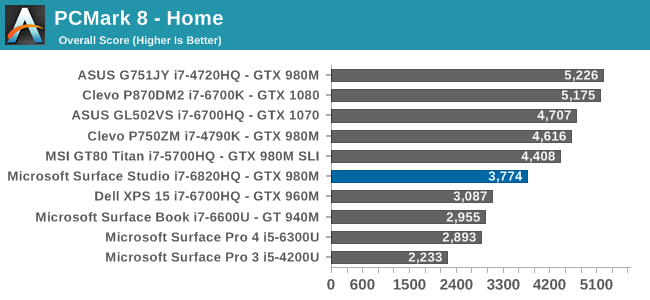

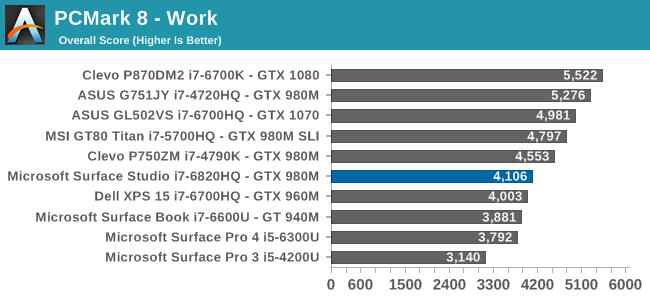
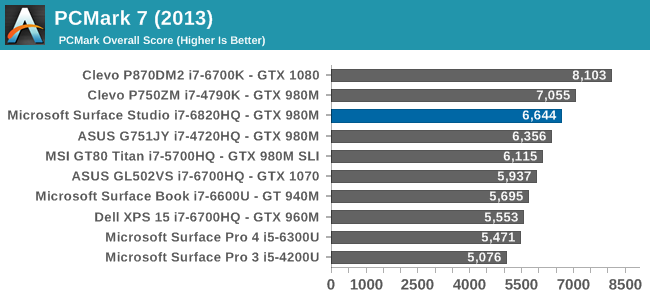
PCMark is a comprehensive set of tests, which uses real-world applications to test system responsiveness and performance. All aspects of the system are tested, including the storage, and even display resolution can have an affect. Here the Surface Studio is decidedly average, with decent scores in some tests, but less than amazing results in others. The hybrid storage and high display resolution likely didn’t help out the Surface Studio here.
Cinebench
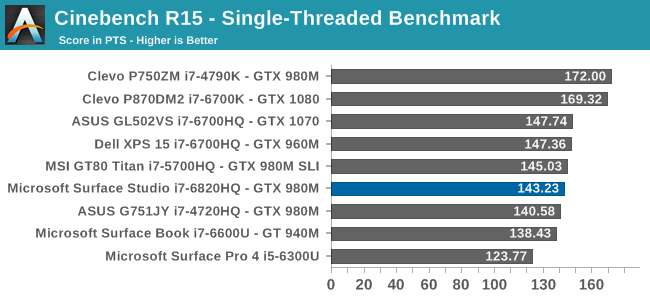
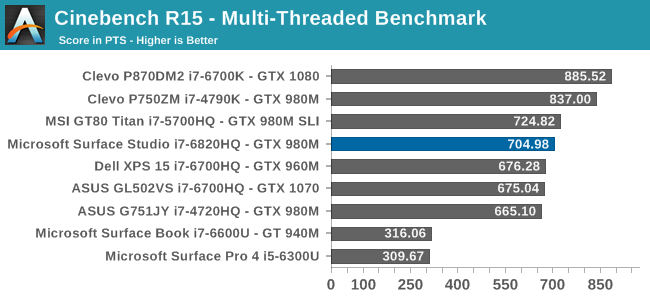
Cinebench is a purely CPU test, and despite the Surface Studio having a Core i7-6820HQ when most quad-core laptops are the i7-6700HQ, it still fell slightly below them on this test.
X264
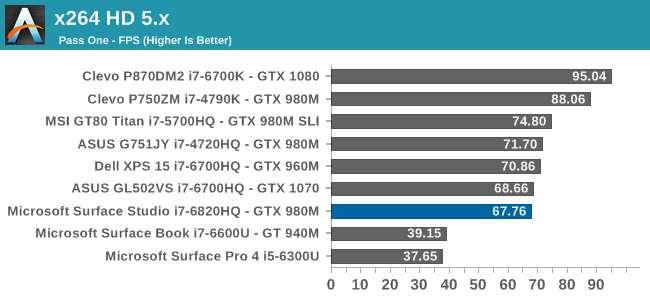
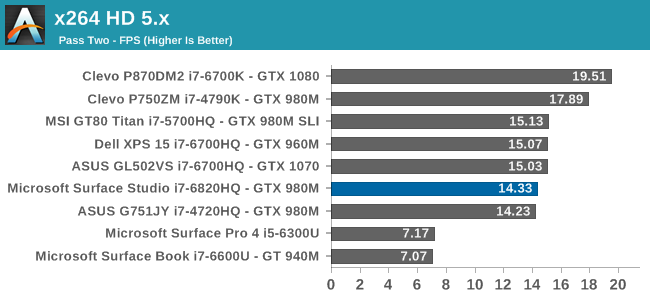
Much like Cinebench, this is a pure CPU test, but unlike Cinebench which renders an image, x264 encodes a video file. As with Cinebench, the Surface Studio falls a bit under the performance of the i7-6700HQ found in most notebooks.
Web Tests
Browsing the web is likely what most computers do, most of the time, but unlike the previous tests, web tests are always evolving over time as the underlying browsers are updated. For our tests, we use the latest version of Microsoft Edge.
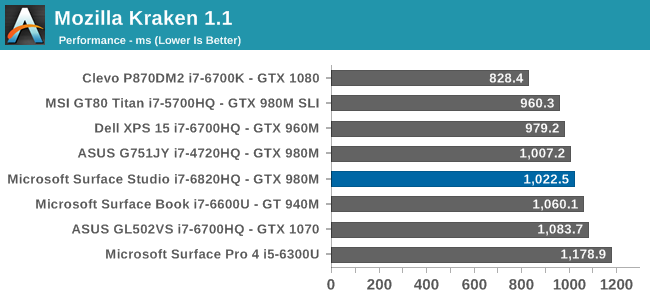
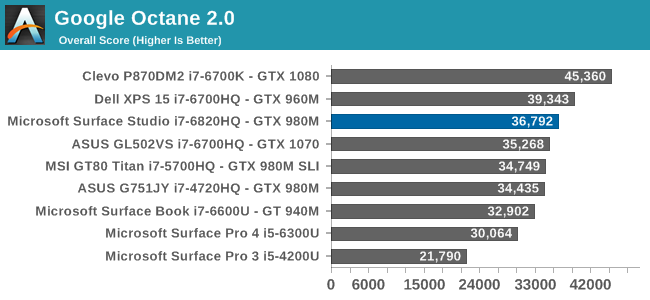

As with the other tests, the Surface Studio falls just a hair under the performance of typical quad-core laptops. With a sample size of one, it’s difficult to point the finger at why this is – is it cooling or is it something else – but I would have expected it to be just slightly ahead of the i7-6700HQ machines.










197 Comments
View All Comments
Devo2007 - Friday, January 20, 2017 - link
With all the bugs of the Surface Pro 4 tablet and Surface Book, I wouldn't call either of them among the best. As for the Surface Studio, it is aimed at such a niche audience that it will probably be quite some time before we see any major issues pop up, but I won't be surprised when (not if) they do.ingwe - Friday, January 20, 2017 - link
I have a Surface Pro 4 for work and it locks up at least once a day. Sometimes it doesn't recognize the type cover that I have. It took me a while to sort out the battery drain issue while it was sleeping. It frequently locks up while restarting. Literally the exact hardware that I want and the software just seems to be so buggy. It's a real shame.BurntMyBacon - Friday, January 20, 2017 - link
That's a shame. I would've hoped it would behave more like the Surface Book given the same software and similarities in the hardware.I haven't had any issues with my Surface Book thus far that weren't a result of my own software and configuration choices. No lockups at all to this date. Some quirky behavior with Edge early on that got fixed with updates (All Win10 devices?). Abnormal pauses were reproducible on a desktop Win10 system and I've adjusted my configuration to eliminate this issue on both. Games work well enough despite not getting the latest nVidia drivers. My uncle said he had some issues with his early on, but it didn't take them long to resolve them.
I'll have to keep in mind that the Surface Pro 4 experience isn't necessarily the same as the Surface Book experience.
nikon133 - Sunday, January 22, 2017 - link
In my experience, Surface Pro 3 is much more stable platform than Surface Pro 4.Had a chance to use both, actually switch between SP3 and SP4 a few times. On paper, SP4 would be my choice - less heat, less fan activity, slightly bigger, better, higher res screen... a bit lighter, too.
However... I had chance to play with two SP4. One was repaired/refurbished, the other one brand new. Solid 5 months in-between, so they couldn't be same batch. Both SP4 exhibited touch-screen issues... at some point, every couple of days or so, screen would stop reacting to touch. Type cover would work. Reboot later, touch screen is back, no errors in event log to point to driver crashing or any other observable problem. This was kind of "fixed" at some point, where touch-screen would stop reacting, and then start reacting on its own, after a few seconds, as if Windows was restarting touch-screen tech/software automatically on detected problem, so no need to restart whole Surface... basically more of a workaround than real fix. Refurbished one also had problem with Halo - face recognition was a bit of hit-and-miss, even under good light. Seemed to be very sensitive to distance between camera and face, as if DoF was really shallow. The new one was much more reliable with Halo tech (software updates that were released in the meantime, or refurb had somehow flawed Halo hardware?). Both SP4 had a bit of an issue with my LinkSys ADSL modem/router which I also used as wireless AP. Arguably that part might have been down to ADSL device, but then again - two SP3 I have been using had none of these issues.
mr_tawan - Wednesday, January 25, 2017 - link
My SP3 does not detect the type cover quite often. Not really sure if it's physical damage or software issue though. I'm considering getting a cheap chinese cover which runs on bluetooth instead of the i2c interface. Even if the connector is damaged, the keyboard should still works (downside is I have to recharge the keyboard once in a while, and have to turn it on or off manually)Other than that my SP3 runs pretty solid, although the GPU is pretty much underpowered.
mr_tawan - Wednesday, January 25, 2017 - link
Oh and since my keyboard is out of warrantee now, getting a replacement is almost the same price as buying a new one.swaaye - Friday, January 20, 2017 - link
The only problem I've had with my Surface Pro 4 is screen flicker when it's at low brightness. It's only a problem in a dark room when brightness is about 10%. But yeah I have heard about all the other issues people have seen with them.Samus - Friday, January 20, 2017 - link
We had a lot of problems with a whole batch of Surface 3's at a law office. Eventually Microsoft agreed to swap them all for Surface 4's. Problems from battery performance to two of them just outright dying.vLsL2VnDmWjoTByaVLxb - Friday, January 20, 2017 - link
On my Fourth Surface Book since buying one pre-order back in October 2015. I need to turn it in for a fifth one later this month. The device(s) have never worked to my satisfaction. The first three suffered from graphical glitches, crashes, wakeup oddities, and strange glitches. The one I'm on now will randomly have the keyboard/mouse stop functioning after waking up, inability to wake up, and the hinge is "loose" so that the Surface Book frequently thinks it is detached/reattached. So tired of dealing with this thing.damianrobertjones - Friday, January 20, 2017 - link
Then get a refund and perhaps move on? After the second I'd have asked for a refund or sold it.